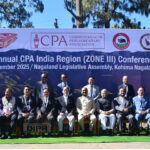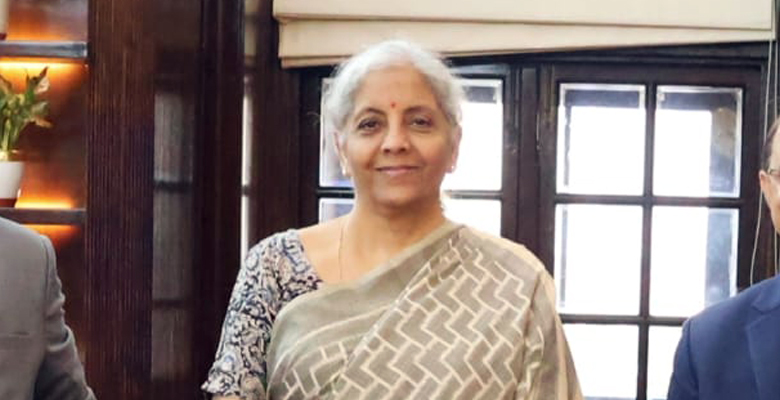The Question of Frontier Nagaland – Revisiting the Formation of Federal Units in India through a Constitutional Process | Dr. Aniruddha Babar, Dept of Political Science, Tetso College
“CONSTITUTIONAL MORALITY IS NOT A NATURAL SENTIMENT. IT HAS TO BE CULTIVATED”
~ Dr. B.R. Ambedkar
Before independence, India was divided into 565 princely states. These indigenous princely states believed in independent governance, which was the biggest obstacle in building a strong India.
At this time India had three types of states (1) ‘Territories of British India’, (2) ‘Princely states’ and the colonial territories of France and Portugal.
After the Indian independence; 562 princely states had nodded to join the Indian Confederation except Hyderabad, Junagadh, Bhopal and Kashmir.
Since the Indian independence the boundaries of the Indian states keep on changing year by year.
From 565 princely states and 17 provinces before partition, to 14 states and 6 Union Territories following the Reorganisation of States in 1956 to 29 states and 7 union territories in 2014, now after the bifurcation of Jammu & Kashmir to 28 states and 9 Union Territories after it.
In the 1950s, the nature of demands for a new state was based on the ‘identity’ aspect under federal governance; but at present, the focus has shifted to ‘regional development,’ particularly to the aspects of socio-cultural, economic and political opportunities. Moreover, it is also focusing on several other dimensions such as administrative accountability, economic development, stable political order and participation of all communities of the concerned state as per the constitutional mandate.
The main objective of adopting the federal structure in Indian polity was to promote cultural homogeneity and improved federal governance in all the Indian states. However, the unequal development between the states, regions within the state and lack of socio-economic and political opportunities in society has directlychallenged federalism in India. This complex situation has opened the door for the ‘concerned entities’ to fight against the discrimination. Therefore, the separation, creation or alteration of a state has great importance. Political movement for the separate state of the Frontier Nagaland is undoubtedly have been resulted out of the broken federal structure as well as fractured governance in the context of the State of Nagaland which completely failed to give guaranteed constitutional justice to people living in the Eastern region of the state.
Before the Constitution came into being, there was also a huge debate over the use of the terms ‘federal’ and ‘union’ in the Constituent Assembly. The debate continued between the Union Constitution Committee under the chairmanship of the then Prime Minister Jawaharlal Nehru and the Drafting Committee chaired by Dr. Babasaheb Ambedkar. Finally, the word ‘union’ was incorporated in the Indian Constitution as per Ambedkar’s suggestion. The ‘Union of States’ implies a federal constitution based on a dual polity, he clarified because; the Federal Constitution can provide the expression of regional goals and national objectives. It also aims to accommodate various aspirations and sovereign interests of different provinces with ethnic groups and linguistic characteristics.
In 1953, the States Reorganization Committee (SRC) was established to look after the issues of reorganization of states in India. It recommended some basic principles of reorganizing of the states as preservation and strengthening of unity and security of India, linguistic and cultural homogeneity, financial and administrative efficiency and the successful working of the 5-Year Plans.
Continuing with the constitutional discourse, it is good to be reminded that one of special features of the Union of India is that the union is indestructible but the power conferred on Parliament includes the power to form a new state or union territory by uniting a part of any State or Union territory to other State or Union territory. The identity of States can be altered or even expunged by the Parliament. The Constituent Assembly declined a motion in concluding stages to designate India as ” Federation of States”.
Article 1 of the Constitution defines India, that is, Bharat as a ‘Union of States’. The reasons behind this made clear by Dr. B.R. Ambedkar in the Constituent Assembly. Ambedkar said the Indian Federation was a “Union” because it was inseparable, and no State had the right to withdraw from the Indian Union. He said “The Drafting Committee wanted to make it clear that while India was going to be a federation, the federation was not the product of an agreement between states to join the federation, and that since the federation was not the consequence of an agreement, no State had the right to withdraw from the federation. The Union is a federation because it is indestructible. Although for the convenience of administration, the country and people can be divided into different States, the country is an integral whole, its people a single people living under a single imperium coming from a single source. The Americans had to wage a civil war in order to make sure that their federation was indestructible and the States had no right of secession. The Drafting Committee was of the opinion that it was better to make it clear at the outset than to avoid speculation or dispute”.
Article 2 of The Constitution Of India speaks about Admission or establishment of new States: Parliament may by law admit into the Union, or establish, new States on such terms and conditions, as it thinks fit.
Article 3 of Indian Constitution addresses the topic of ‘Formation of new States and alteration of areas, boundaries or names of existing States’. It says; Parliament may by law
- a) form a new State by separation of territory from any State or by uniting two or more States or parts of States or by uniting any territory to a part of any State;
- b) increase the area of any State;
- c) diminish the area of any State;
- d) alter the boundaries of any State;
- e) alter the name of any State;
Provided that no Bill for the purpose shall be introduced in either House of Parliament except on the recommendation of the President and unless, where the proposal contained in the Bill affects the area, boundaries or name of any of the States, the Bill has been referred by the President to the Legislature of that State for expressing its views thereon within such period as may be specified in the reference or within such further period as the President may allow and the period so specified or allowed has expired Explanation I In this article, in clauses (a) to (e), State includes a Union territory, but in the proviso, State does not include a Union territory Explanation II The power conferred on Parliament by clause (a) includes the power to form a new State or Union territory by uniting a part of any State or Union territory to any other State or Union territory.
The objective seems to have been to grant an opportunity to the State legislature to express its view within the stipulated time period. If the State Legislature fails to avail itself of the opportunity such failure would not invalidate the introduction of the Bill (Babulal Parante v. State of Bombay). There is nothing in the proviso to indicate that Parliament must accept or act upon the view of the State Legislature. Indeed State Legislature/s may express totally divergent views. All that is contemplated is that the Parliament should have before it the views of the State legislature to the proposals contained in the Bill and then be free to deal with the bill in any manner it thinks fit and following the usual practice and procedure prescribed by and under the rules of business.What is to be referred to the State Legislature is the proposal contained in the Bill. It is not necessary that every time an amendment of the proposal contained in the bill is moved and accepted, a fresh reference should be made to the State Legislature.
Parliament has been vested with the exclusive power of admitting or establishing new states, increasing or diminishing the area of an existing State or altering its boundaries, the legislature or legislatures of the States concerned having only the right to an expression of views on the proposals. For making such territorial adjustments it is not necessary even to invoke the provisions governing constitutional amendments.
Article 3(a) enables Parliament to form a new State and this can be done either by the separation of the territory from any state or by uniting two or more States or parts of States, or by uniting any territory to a part of any state. There can be no doubt that foreign territory which after the acquisition becomes a part of the territory of India under Article 1 (3) (c) is included in the last clause of Article 3 (a). Thus Article 3(a) deals with the problem of the formation of a new state and indicates the modes by which a new state can be formed.
Article 3 (b) provides that a law may be passed to increase the area of any State. This increase may be incidental to the reorganization of States under Article 3 ( b ) may have been taken out from the area of any state may also be the result of adding to any state any part of the territory specified in Article 1 (3) (C). Article 3 (d) refers to the alteration of the boundaries of any State and such alterations would be the consequence of any of the adjustments specified in Article 3 (a),(b),(c). Article 3 (e) refers to the alteration of the name of any State.
In R.C. Poudyal & Ors. v. Union of India, Article was discussed and it was observed: “It cannot be predicted that the article confers on Parliament an unreviewable and unfiltered power immune from judicial scrutiny. The power is limited by the fundamentals of the Indian constitutionalism and those terms and conditions which the Parliament may deem fit to impose, cannot be inconsistent and irreconcilable with the foundational principles of the Constitution and cannot violate or subvert the constitutional scheme. The validity of a statute is to be tested by the constitutional power of the Legislature at the time of its enactment by that Legislature, and if thus tested, it is beyond the legislative power, it is not rendered valid.”
Article 4 states that any law referred to in Article 2 or Article 3 shall contain such provisions as required to amend the 1st Schedule and IV Schedule in order to give effect to the provisions of the law and may also contain such specific, incidental and consequential provisions as the provisions may be considered necessary by the Parliament may deem necessary. Article 4 allows for consequential changes to the First Schedule (names of the States in the Union of India) and the Fourth Schedule (number of seats allocated by each State to the Rajya Sabha). It also notes that it does not consider a constitutional amendment under Article 368. It also states that no law existing States or creating a new State will be considered a constitutional amendment. It is in line with the previous provisions of the requirement, of a simple majority in Parliament and suggests full control of the Union over the territories of the individual States of the Union.
The Frontier Nagaland Movement- a decades old political movement of the Eastern Naga people for a separate state has now reached a very crucial moment. Government of the Union may fulfill the demand for a separate state by granting either complete state or Union Territory. I do not see any third option, nor do I see any need for the union government to invent any third option to give justice to the people of Eastern Nagaland. The rights of the people needs to be protected in the spirit of constitutionalism which in-fact derive its mandate from the core of the democracy that is ‘WE THE PEOPLE OF INDIA’.
Constitutionally speaking, the destiny of Eastern Nagas will be well protected either in full-fledged State or Union Territory. Any other experiment like what was done in case of Meghalaya by granting it Autonomous State within the state of the then Assam will cause further constitutional disaster as Assam Reorganization (Meghalaya) Act, 1969 itself proves theillusive and illusionary nature (refer Sec. 36,59,60,61,67,68,70 of the said Act) of the arrangement which did not last even for a year.
On 11 September 1968 the Government of India announced a scheme for constituting an autonomous state within the state of Assam comprising certain areas specified in Part ‘A’ of the table appended to paragraph 20 (titled as ‘Tribal Areas) of the Sixth Schedule to the Constitution. Accordingly, the Assam Reorganisation (Meghalaya) Act of 1969 was enacted for the formation of an Autonomous State.The Act came into effect on 2 April 1970, with the Autonomous State having a 37-member legislature in accordance with the Sixth Schedule to the Indian constitution.
Constitutional history of this one and only experiment teaches us that its constitutionality and constitutional validity can be found in the ‘Sixth Schedule’ of the Constitution of India. Entire region of the then tribal region of Meghalaya was a part of sixth schedule which Naga people denied in totality in the past. Autonomous State of Meghalaya was made possible because Khasi Hills, Jaintia Hills and Garo Hills have been put under the protection of Sixth Schedule of the Constitution of India. Autonomous State experiment can be made constitutionally possible in case of all those regions under sixth schedule, but it is certainly not possible in the case of state of Nagaland which is a result of Art. 371 A that originally resulted out of 16 Point Agreement. Therefore, the logical and constitutional conclusion of frontier Nagaland movement will either be in full-fledged state or Union Territory not in any ancillary experiment as was done in case of Meghalaya.
It is said that the Constitution is the supreme law of the land. The Parliament is a body empowered to make laws for the welfare of the people, but in doing so, the Hon’ble Government of the Union, Members of the Parliament need to ensure that the legislation that is presented and enacted does not derogate from the constitution and, above all, does not have to be in breach of the basic structure of the constitution of India.
The valid concerns and demands of the Eastern Naga people are fully redressable under well-defined constitutional mechanism and the processes. Union Government need not resort to any ‘extraordinary’ measures to fortify the rights and interests of the Eastern Nagas where regular measures-in their absolute capacity are fully available to be executed to achieve the ‘desired’ results.



